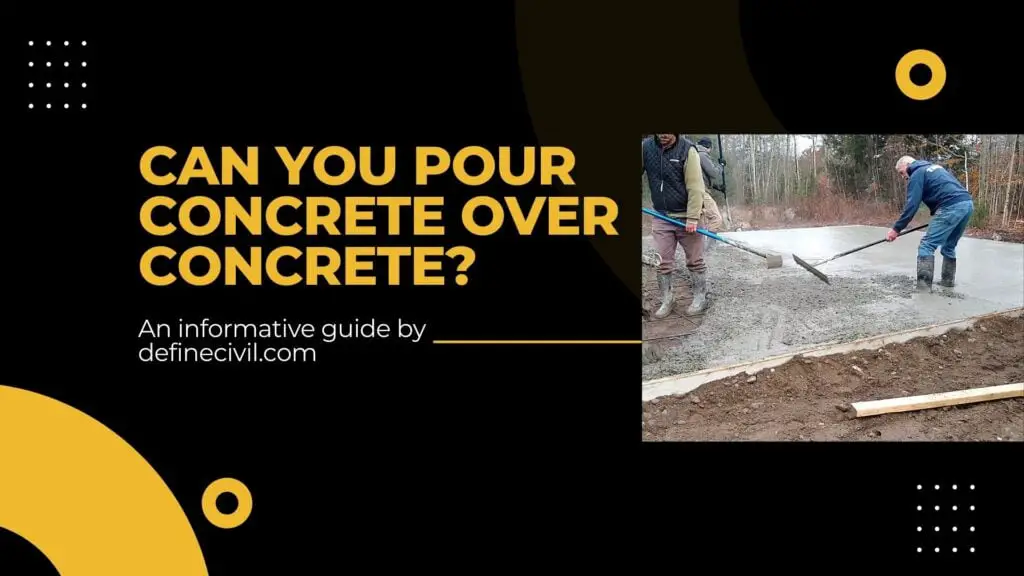Let’s be honest, a lot of homeowners are wondering if one can pour new concrete over existing concrete and will it stick? That’s one way of escaping an entire concrete slab replacement – which is obviously a costly venture. Well; adding a layer of concrete over a cracked concrete patio can instantly revitalize the flooring. Similarly you can instantly boost the look of your concrete driveway by resurfacing. Although it is a cheap way of refurbishing a concrete slab but you need to put more thoughts into it.
Can you put a thin layer of concrete over concrete?
If you’re thinking about pouring thin layer of concrete over concrete, you should first ask yourself how to make it stick. It may seem like the easiest way to fix an old patio or driveway. But the process can sometimes be complex and can be even expensive if not done right. So, before starting this kind of project, make sure you check out this guide on Can You Pour Concrete over Concrete?
I’ve summed up everything you need to learn about how to pull it off in the best way possible!
Can you pour concrete over concrete driveway?
Concrete is a material that’s used for construction. Concrete is simple. It’s made with cement, water, and sand. The mixture must be poured immediately after it’s mixed to avoid losing strength from drying out. You may already know its use as concrete blocks. Masons make walls by stacking and attaching them together in a pattern one above the other.

No matter how sturdy the concrete finish is; it is not immune to damages. Elements like frost, free-thaw, weather, rain, traffic, and loading take a hard toll on the driveways, garage floors, sidewalks, and porches. Once you notice the concrete slab is chipped or has cracks or even if looks weird – you can resurface the old concrete.
But can you pour concrete over concrete?
First select the Thickness
Yes you can – but it depends. The answer is not that simple. The biggest factor to consider is the thickness of the new concrete slab. If you intend to pour a concrete slab of more than 3 inches it can stick and stay there. But it the thickness is less than 3 inches; you need to use a bonding agent to attach new concrete to old concrete.
Evaluate the existing layer
The factor to consider is the underlying support. For slabs the subgrade or supporting old surface has to be structurally sound. Don’t ignore this requirement. Try to visually inspect the structural condition of the existing layer for any settlement or shear failure.
Do you know? The best way to overlay or repair an existing concrete is with the help of gypcrete- Learn more about gypcrete.
Benefits of resurfacing the old concrete
If you’re ready to redo a concrete driveway or patio, you might be curious about how to pour fresh concrete over existing concrete. It can be done, but it’s not ideal for all situations. Read on to learn more.
For many homeowners, replacing a damaged sidewalk or patio is as simple as getting down on their hands and knees with a hand trowel and bucket of premixed concrete. That’s fine if they want their project to look like a DIY job and last five years at most. But others want to use poured-in-place concrete in applications where longevity matters.
How much does it cost?
In short, yes, you can pour concrete over existing concrete—as long as it’s not load-bearing. The rules for pouring concrete floors and walls are a little different than for pouring normal foundations and structures. If you want to follow city codes or if you’re building an actual structure that needs to bear weight (not just filling in an old one), then you should talk to a professional first.
Can You Fill Potholes with Concrete?
If you can’t avoid a pothole, do yourself and your car a favor by simply driving around it. If you can’t, there are a few ways to repair them. Using hot asphalt will cause your car to vibrate while driving over it, but it is effective at repairing large potholes. Smaller holes in roads can be filled with cold patch or concrete. However, pouring concrete on top of concrete isn’t recommended for safety reasons.
How Do You Attach New Concrete to Old Concrete?
Before pouring a new concrete slab on top of an existing one, make sure you follow these steps to ensure they are firmly and securely attached. Doing so will save you a lot of headache in case there is any settling or cracking at a later date.
Cleaning:
It’s a dirty job, but somebody has to do it. But how much cleaning is too much cleaning? The answer depends on what you’re trying to clean. For example, you can safely pour new concrete over old concrete; in fact, sometimes pouring new concrete over old is your best bet. Similarly, pouring mortar over existing mortar (between bricks or stones) is sometimes necessary—but only if there’s no risk of leakage or moisture damage from doing so.
Install a Bond Breaker:
If you’re pouring new concrete over old, chances are it’s because your current slab is cracked or damaged in some way. To ensure that your new slab does not suffer from a similar fate, use a cement bond breaker to create an effective barrier between old and new concrete. The most common kind of bond breaker is asphalt-based and can be purchased in roll form. When used correctly, you can pour new concrete right over an existing surface without worrying about its adhesion or safety.
Place the New Concrete:
Before you start pouring, check your subfloor and make sure it’s level. If it isn’t, use shims or fillers to create a level surface. You can also hire a professional flooring contractor who specializes in concrete floors to help with leveling issues. Next, mix your cement thoroughly by slowly adding water as you go. Once you have one good batch of concrete in your wheelbarrow, spread it on top of your subfloor until smooth and even. Then let it sit for about ten minutes. When your concrete dries, try stamping on it using both feet at once—if it feels hard but not brittle, you’re ready to move on!
Create Crack Control Joints:
One way to create a level concrete surface is to run horizontal and vertical control joints through it, so that as it dries, shrinkage cracks can be spotted early and smoothed over. These are called control joints and are typically 1⁄4 inches wide. They’re created using a grooving tool that forms an indented line in the wet concrete, creating an impression or groove while allowing excess material to flow into place and self-clean.
Minimum concrete thickness over existing concrete
I have talked to a lot of deck and patio concrete contractors and they are of the opinion that about 2 to 2 ½ inches is the minimum thickness of new concrete over old concrete. Anything less than two inches will act as a paper layer. Such a thin layer will not stay or stick for too long.
So, if you want to overlay an existing concrete, I’d recommend go for at least 3 inches in thickness. Obviously the cost will be more but it will pay off in the long run.
Conclusion:
Sure, you can pour concrete over existing concrete. However, pouring a fresh layer of concrete over existing concrete isn’t recommended and here’s why: Any holes in your underlying layer of concrete—say from corroded rebar or wire mesh from an earlier project—will act as a conduit for water to enter your new surface once it’s poured. This can lead to problems like spalling and cracking that will diminish the life of your new flooring.



















